Intel
NAS Performance Toolkit
Intel NASPT is a disk subsystem test using
real usage scenarios. Like PCMark 7, Intel NASPT re-appears predefined disk
activity traces and measures how fast the the speeds of SSDs are performed.
However, the default traces are for storage device network rather than for the
SSDs. So in our test session, we replace them with the SSD Benchmarking Suite
developed specially in which provides more relevant usage scenarios such as compressing
and decompressing files, compiling large projects, copying files and folders,
downloading 3D game levels, installing software, creating a series of images,
looking for a digital library for data, launching mass-applications and
transcoding videos.
Similarly to the PCMark 7, this benchmark
shows us a real-life illustration of the disk subsystem performance. Here, the
SSDs are tested in their "steady" state again.

INASPT,
SSD Benchmark Suite
We think that Intel NASPT offers a
realistic picture of SSD performance, and the OCZ Vertex 3.20 performs in a
special way here. For example, it is not the worst of the SandForce-based SSDs
in this comparison; this shows optimizations aimed at improving its performance
in realistic conditions. As a result, it goes ahead the Corsair Force GT and
Corsair Force GS, which are the products based on the SF 2281 controller
platform, have synchronous flash memory and employ the reference SandForce
firmware. On the other hand, the new products of OCZ are unlikely to suit the
Intel 520 or Kingston SSDNow V300, which give high performance thanks to deep
software customization. Thus, the Vertex 3.20 itself can be accurately
commented as follows: it stands behind the OCZ Vector and Vertex 4, but before
many competing products from other brands.
Besides the average benchmark score, we
also want to give you the results of the specific usage cases, which will
indicate where the OCZ Vertex 3.20 may actually shine. We wish you to take
notice that the high data transfer speed is higher than the SATA 3 interface
bandwidth in some subtests. That's because INASPT is a high-grade test that
utilizes standard Windows functions to access the disk subsystem. As a result,
the OS caching mechanisms also influence the results.

The
speed of compressing files

The
speed of compiling
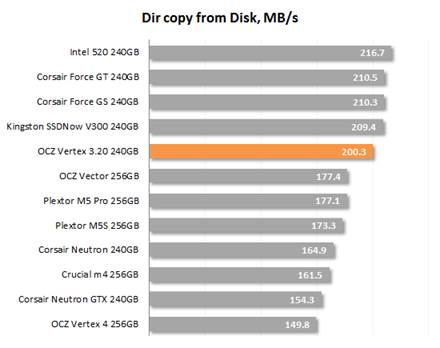
The
speed of copying files directly from the hard drive
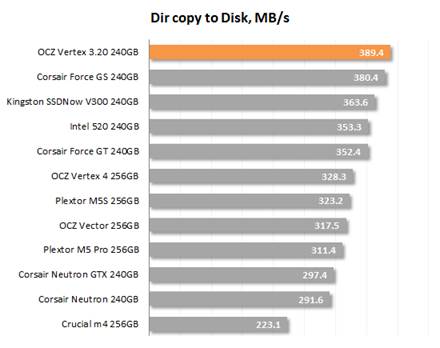
Speed
copying files directly over the hard disk

The
speed of copying files from the hard disk
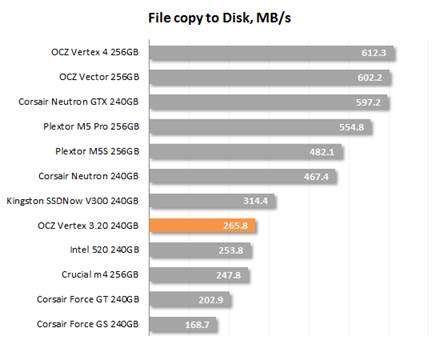
The
speed of copying files to the hard disk

The
speed of gaming
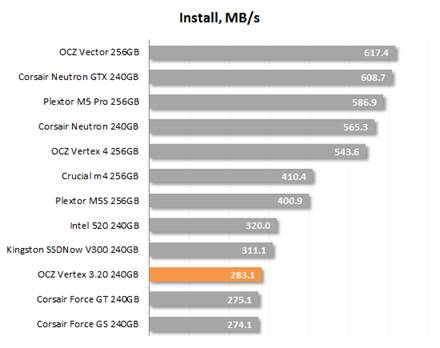
The
speed of installing
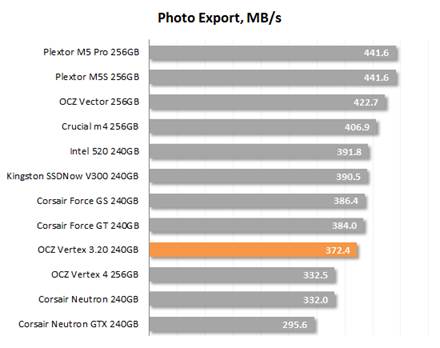
The
speed of exporting images

The
speed of searching
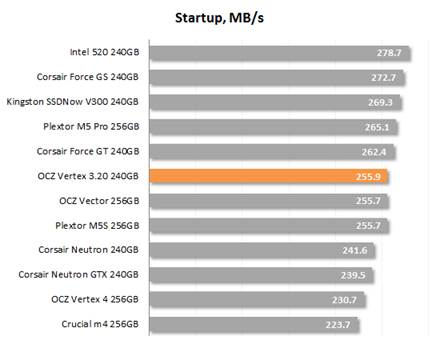
The
speed of starting up

Video
transcoding results
We can note that the Vertex 3.20 takes more
advantages over some other SSDs with SF-2281 controller and synchronous MLC
flash in terms of the process of writing files and folders. But when talking
about reading, the Vertex 3.20 lags behind. OCZ emphasizes this fact in its
official specifications and we found the same in our synthesis tests. That's
why the new SSD is nearly leading solutions. It is a reasonable product with
the speed characteristics even by the SandForce’s own standards.
Speed of copying files
We utilize AS SSD version 1.7.4739.38088
test to score the speed of copying different types of files in a unique
partition the size of the entire SSD. The SSDs are tested in their stable
state.

The
results of copying files, ISO
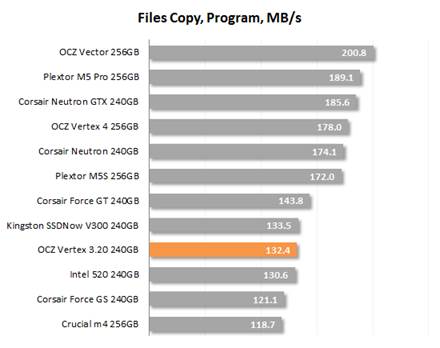
The
results of copying files, programs
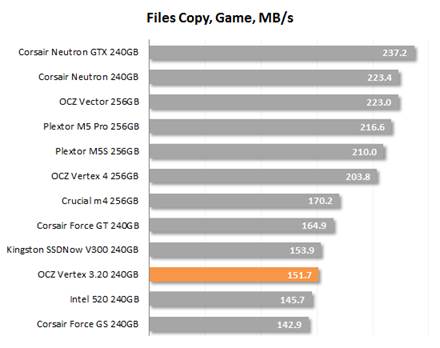
The
results of copying files, games
The OCZ Vertex 3.20 has the better results
than other SandForce-based SSDs at writing files, but is worse in the process
of reading files. That's why it provides average performance in the copying test
which includes both writing and reading texts. It is also slower than common
SSDs that are based on Indilinx, Marvell and LAMD controllers.
Conclusion
Of course, the SSD manufacturers do not
want to gain any levels of high performance by introducing new products with
the LSI SF-2281 controller, especially OCZ. This company has long been using
its own controllers for its top-leading SSDs. The SandForce is a time-tested
inexpensive platform to help make the new SSDs with acceptable specifications
without much effort. Thus, all recently announced SSDs with SF-2281 controller
have to be discussed the price / performance ratio in the first part. They are
positioned as the major solutions for the consumers who are aware of the
prices.
That is the reason why there is nothing
wrong when saying that the new OCZ Vertex 3.20 does not work faster than the
reference SandForce SSDs with 25nm synchronous flash from Intel (like the
Vertex 3 series which the Vertex 3.20 appears to replace) . The main point is
that it is cheaper and the transition to the 20nm memory flash of Intel also is
meant to alleviate the manufacturing cost in the first place. Unfortunately,
our testing shows that OCZ has opted for optimal hardware configuration for
this model. The Kingston SSDNow V300 we have considered recently employs the
same SF-2281 controller but provides better performance and lower price even
though it is equipped to switch to the 19nm flash mode of Toshiba. Of course,
OCZ can adjust its pricing policies towards the Vertex 3.20 models but it is
difficult for us to be able to recommend what SSDs you should select right now,
considering the availability of very strong alternatives.
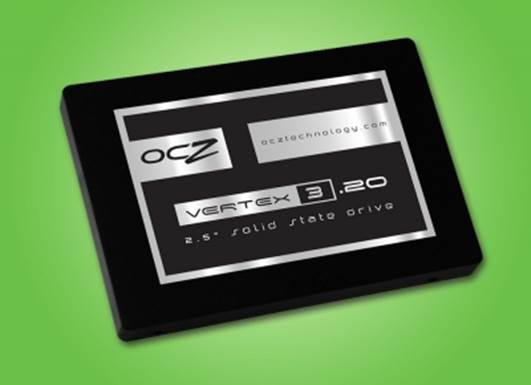
The
product image
In addition to that, the OCZ Vertex 3.20
inherits all of the typical drawbacks of SandForce-based products such as its
performance is not too high (by today's standards) that tends to degrade over
time due to the inefficient garbage collection algorithms. In other words, if
you wish a high-performance SSD, you should look for it at the other addresses.
OCZ itself provides faster alternatives by the Vector and Vertex 4. And if you
need a cheap SSD, the Vertex 3.20 may be considered only if it costs less than
the other SandForce-based products with synchronous flash
To help you choose, we give you the
following summary with the test results of different SSDs. It consists of basic
hardware information about SSDs we have tested up to now and allows to quickly
defining the general position of the specific model among its rivals in terms of
the relative performance.
|
The OCZ
Vertex 3.20 technical specifications
·
The controller: SandForce SF-2281
·
Interface: SATA 6Gbps
·
Flash memory: 20 nm synchronous MLC flash
·
Capacity: 240 GB (224 GiB)
·
Sequential read speed: 550 MB/s
·
Sequential write speed: 520 MB/s
·
Random read speed (4 KB blocks): 35,000 IOPS
·
Random write speed (4 KB blocks): 65,000 IOPS
|